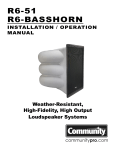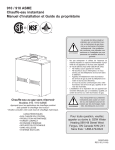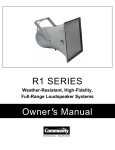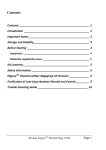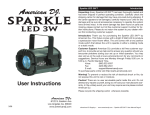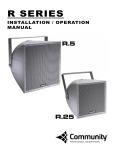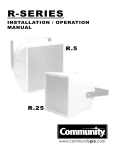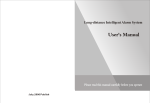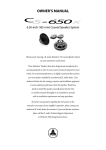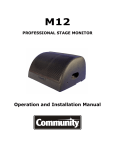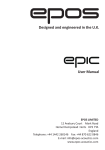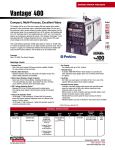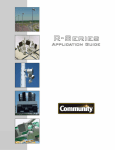Download RMG-200A RMG-200AT - Community Professional Loudspeakers
Transcript
RMG-200A RMG-200AT INSTALLATION / OPERATION MANUAL Weather-Resistant, High-Output, Loudspeaker Systems EC STATEMENT OF CONFORMITY E C S TAT E M E N T O F C O N F O R M I T Y This document confirms that the range of products of Community Professional Loudspeakers bearing the CE label meets all of the requirements in the EMC directive 89/336/EEC laid down by the Member States Council for adjustment of legal requirements. Furthermore, the products comply with the rules and regulations referring to the electromagnetic compatibility of devices from 30-August-1995. The Community Professional Loudspeaker products bearing the CE label comply with the following harmonized or national standards: DIN EN 55013:08-1991 DIN EN 55020:05-1995 DIN EN 55082-1:03-1993 The authorized declaration and compatibility certification resides with the manufacturer and can be viewed upon request. The responsible manufacturer is the company: Community Light & Sound 333 East Fifth Street Chester, PA 19013 USA TEL: 1-(610) 876-3400 FAX: 1-(610) 874-0190 Chester, PA USA March 2011 FIND THE LATEST ONLINE Every effort has been made to ensure that the information contained in this manual was complete and accurate at the time of printing. However, due to ongoing technical advances, changes or modifications may have occurred that are not covered in this publication. The latest version of this manual and the most recent product information published by Community is always available at http://www.communitypro.com. Community RMG-200A and RMG-200AT Installation / Operation Manual — Page 2 WELCOME TO COMMUNITY A T R AD I T I O N O F E X C E L L E N C E AN D I N N O VAT I O N . . . S PAN N I N G M O R E T H AN 4 0 Y E AR S ! Since the founding of our company in 1968, Community has been a constant developer and innovator of loudspeaker technology. Many of our engineering achievements were undertaken to solve problems, when no prior solutions existed, while others were the result of simply seeing a better way to do things. Over the years our technologies have been imitated, and our methods have become common practice throughout the professional sound industry. However, developments like carbon fiber diaphragm compression drivers still stand alone, and well ahead of the competition. Just a few of Community’s unique accomplishments include the following: First successful fiberglass mid-frequency, high-frequency, and large-format bass horns. First compression loaded mid-range horn for touring systems - the LMF. First suspension-less diaphragm HF driver - the VHF100. First mid-range, full-decade (200 Hz - 2 kHz) high-power compression driver - the M4. First carbon fiber diaphragm compression drivers - M4, EM280, EM282. First Ferrofluid-cooled professional woofers - the VBS Series. First product series with all drivers Ferrofluid-cooled. First air-cooled loudspeakers for touring systems - AirForce. First three-way cinema loudspeaker systems - Paramount Executive Studio Theatre, Warner Bros. screening theatre and dubbing rooms. First electro-acoustic system to equal the sound level of pneumatic warning sirens. First to provide loudspeaker coverage over an entire country - Denmark Emergency System. First comprehensive, calibrated data acquisition of sound reinforcement products. First integral signal-aligned three-way sound reinforcement systems - RS Series. First pro audio company with an Internet Web site. First all horn-loaded, high-fidelity, weather-resistant loudspeakers - R2 Series. In line with our history of excellence and innovation, each Community product is manufactured in accordance with a complicated and exacting chain of procedures that ensure absolute quality and uniformity. With our unique designs, our sophisticated techniques, and our proprietary materials and transducers, we are committed to bringing only the finest audio products to the many thousands of professional sound engineers, performers, and end users who rely on them daily. Community Professional Loudspeakers 333 East Fifth Street Chester, PA 19013-4511 USA TEL: 1-(610) 876-3400 FAX: 1-(610) 874-0190 www.communitypro.com © 2011 All Rights Reserved Community RMG-200A and RMG-200AT Installation / Operation Manual — Page 3 TABLE OF CONTENTS TO P I C S EC Statement of Conformity .................................................................................................... Page 2 Welcome to Community .......................................................................................................... Page 3 Important Safety Information ................................................................................................... Page 5 Unpacking, Inspection, and Damage Claims ........................................................................... Page 6 Introduction / Features ............................................................................................................ Page 7 Product Descriptions .............................................................................................................. Page 8 Quick Start-up Guide / Basic Features .................................................................................... Page 9 Signal Processing ................................................................................................................. Page 10 Power Amplification ...................................................................................................... Pages 10 - 11 Use of Protective Limiting ...................................................................................................... Page 11 Electrical Installation / Connecting to the Loudspeaker................................................. Pages 11 - 12 Mounting Point Dimensions ................................................................................................... Page 13 Mechanical Installation ........................................................................................................ Pages 14 Technical Specifications ........................................................................................................ Page 15 System Optimization ............................................................................................................. Page 16 In Case of Difficulty ............................................................................................................... Page 17 Warranty / Service Information .............................................................................................. Page 17 The Complete R-Series Family.............................................................................................. Page 18 R-Series Operating Distances ............................................................................................... Page 19 Contact Information ............................................................................................................... Page 20 Community RMG-200A and RMG-200AT Installation / Operation Manual — Page 4 IMPORTANT SAFETY INFORMATION I M P O R TAN T S AF E T Y I N F O R M AT I O N Always follow these basic safety precautions when using or installing R-Series loudspeakers and accessories: Read these instructions. Keep these instructions. Heed all warnings. Follow all instructions, particularly those pertaining to rigging, mounting, suspension of the product, and electrical connections. The terms IMPORTANT, CAUTION, and DANGER are used throughout this manual to alert the reader to important safety considerations. If you have any questions or do not understand the meaning of these terms, do not proceed with installation. Contact your local dealer, distributor, or call Community directly for assistance. These terms are defined below: IMPORTANT: describes an operating condition or user action that may expose the equipment or user to potential damage or danger. CAUTION: describes an operating condition or user action that will likely cause damage to the equipment or injury to the user or to others in the vicinity. DANGER: describes an operating condition or user action that will immediately damage the equipment and/or be extremely dangerous or life threatening to the user or to others in the vicinity. R I G G I N G AN D E L E C T R I C AL S AF E T Y DANGER: The loudspeakers described in this manual are designed and intended to be ‘flown,’ mounted, or suspended for maximum acoustical performance using a variety of rigging hardware, means, and methods. Installation of the loudspeakers should only be performed by trained and qualified personnel. It is strongly recommended that a licensed and certified professional structural engineer approve the mounting design. Severe injury and/or loss of life may occur if these products are improperly installed. DANGER: R-Series rigging fittings are rated at a Working Load Limit (WLL) of 100 lbs. (45.4 kg) with a 10:1 safety margin. No single rigging fitting should ever be subjected to a load that is greater than this stated limit. Failure to heed this warning could result in severe injury and/or loss of life. IMPORTANT: Refer to the sections on installation and connections later in this manual for additional information on rigging and electrical safety. IMPORTANT: The stainless steel mounting bolts that mount the yoke must be kept in place to seal the enclosure from air leaks. If the rigging fittings do not remain sealed, air leaks will occur in the enclosure that will compromise the loudspeaker’s weather-resistance and its low frequency performance. Community RMG-200A and RMG-200AT Installation / Operation Manual — Page 5 UNPACKING U N PAC K I N G AN D I N S P E C T I O N R-Series loudspeakers are inherently rugged and are carefully packed in sturdy cartons. However, it is wise to thoroughly inspect each unit after it has been removed from the packaging, as damage may have occurred during shipping. S H I P P I N G C L AI M S Please note that once the shipment has left your dealer or the Community factory, the responsibility for damage is always borne by the freight company. If damage has occurred during shipping, you must file a claim directly with the freight company. It’s very important to contact the freight company as soon as possible after receiving your shipment, as most freight companies have a short time limit within which they will investigate claims. Make sure to save the carton and the packing materials, as damage claims can be denied if these materials are not retained. If there is evidence of physical damage to the carton upon arrival, be very careful before signing a delivery receipt. Often, the fine print in a delivery receipt will waive your right to file a claim for damage, or loss, after you sign it. Your Community dealer and the factory will try to help in any way they can, but it is the responsibility of the party receiving the shipment to file the damage claim. This is a provision of law in the USA and in most countries. It’s always a good idea to retain the carton and packing materials indefinitely, if possible, in the event that the product may need to be returned to your dealer or distributor for repair in the future. W H AT ’ S I N T H E B O X Each shipping carton contains the following items: (1) RMG-200A or (1) RMG-200AT (1) Swivel Yoke-style Bracket (Fully assembled and attached to RMG-200A/RMG-200AT loudspeaker.) (1) Installation/Operation Manual (1) Warranty Card P U R P O S E O F T H I S M AN U AL This manual is intended to help you install and use the RMG-200A and RMG-200AT loudspeakers safely and effectively. It provides useful information to help you obtain the best performance, sound quality, and reliability from these systems. We’ve provided a Quick-Start diagram to enable you to install and operate the products immediately, but we recommend that you read this manual in its entirety to ensure that your installation meets the highest possible quality standards. Community RMG-200A and RMG-200AT Installation / Operation Manual — Page 6 INTRODUCTION / APPLICATIONS I N T R O D U C T I O N TO R M G L O U D S P E AK E R S All-Weather, All-Purpose The RMG-200A and RMG-200AT are complete horn/driver systems designed for use in stand-alone voice-range sound reinforcement and announcement/signaling applications. The are designed to handle the harshest outdoor environmental conditions, but are often the ideal choice for indoor environments as well. Both models are fully horn-loaded, manufactured from hand-laid fiberglass, and powered by Community’s industry-leading electro-mechanical drivers. Horn-loading provides the highest possible efficiency, excellent transient response, and predictable pattern control - all of which equate to superior performance. Fiberglass construction ensures that these loudspeakers can withstand continual exposure to the elements and are free from the decomposition that can occur over time with wood-based products. Community’s proprietary driver technology provides excellent sonic quality and is engineered for durability and longevity. The driver in both RMG models exhibits exceptional resistance to potentially damaging environmental conditions, as do the enclosures themselves. Both models meet the needs of numerous applications, some of which are listed below: TYPICAL APPLICATIONS Stadiums Voice Warning Systems Industrial Paging Athletic Fields (football, soccer, baseball, tennis) Sports Arenas Racetracks & Motor Speedways Gymnasiums & Field Houses Theme Parks and Amusement Parks Swimming Pools and Water Parks Ski Slopes Cruise Ships Fairgrounds Rodeos Air Shows Skating Rinks Convention Centers Factories & Warehouses Please see our comprehensive 60 page R-Series Application Guide at www.communitypro.com/rseries for advice and information on how to best utilize the R6-51 and R6-BASSHORN, as well as how to utilize other R-Series loudspeakers. The Guide contains a wealth of knowledge, along with numerous examples of successful installations. Community RMG-200A and RMG-200AT Installation / Operation Manual — Page 7 PRODUCT DESCRIPTION P R O D U C T D E S C R I P TI O N The RMG-200A and RMG-200AT provide focused, high output sound projection, with predictable performance and exceptional long-term durability. The horn portion of the assembly is a handcrafted one-piece waveguide, precision molded of hand-laminated, fiber-reinforced glass for optimum performance. Substantial fiberglass layering, and an integral throat and driver flange construction can withstand substantial torque loads. The inherent strength and rigidity of the fiberglass construction enhances sonic efficiency by preventing sound energy loss, as well as providing inherently weatherproof fabrication. The RMG-200AT is a variant of the RMG-200A, but equipped with a high-power, low distortion 75W autoformer for 70V or 100V operation. PRODUCT FEATURES 2-inch (51 mm) throat exit M200 driver, Ferrofluid-cooled High efficiency High power output Non-metallic diaphragm eliminates ‘ringing’ and harmonic distortion Swivel yoke bracket included Highly resistant to harsh environments, IP65 rating with a minimum 5-degree downward aiming angle DRIVER DESIGN The compression driver is a high output, high sensitivity loudspeaker that is configured with the diaphragm facing forward, isolating the voice coil and magnetic structure from the environment. The one-piece, nonmetallic diaphragm and suspension offers exceptional resistance to the effects of humidity, dust, and corrosive atmospheres. The large area and low compression phase plug loading, coupled with a massive magnet structure, exhibits extremely low distortion at high outputs, while maintaining high efficiency and low power compression. A fiberglass rear cover protects the driver from the effects of weather and corrosion. A factory-installed weather-resistant steel swivel yoke bracket is included. We proudly offer a five-year warranty providing protection against manufacturing defects on all components of the system. H I G H - PAS S F I LT E R The RMG-200A and RMG-200AT are horn-loaded loudspeaker systems with a specified low frequency response of 400 Hz. Any attempt to reproduce significant levels below this frequency can result in over-excursion of the driver. For this reason, a 400 Hz 24dB-per-octave electronic high-pass filter must be employed to protect the driver from low frequency content below 400 Hz. Community RMG-200A and RMG-200AT Installation / Operation Manual — Page 8 QUICK START-UP GUIDE B AS I C F E AT U R E S O F T H E R M G - 2 0 0 A & R M G - 2 0 0 AT FEATURE DESCRIPTION 1 Bracket Strap Attachment Points Eight total; two on each side, and two each on the top and bottom surfaces. 2 Yoke Bracket Attaches to the bracket straps. 3 Bracket Clamp Bar Secures the loudspeaker’s angular adjustment. Community RMG-200A and RMG-200AT Installation / Operation Manual — Page 9 SIGNAL PROCESSING & AMPLIFICATIONS E Q U AL I Z AT I O N Small amounts of frequency boost can brighten-up the higher frequencies and round out the lower frequencies, but they should be restricted to no more than approximately +3 dB in order to avoid damage to the drivers. Equalization cuts can be very effective for removing the effects of room resonance and other unwanted acoustical artifacts, but here again should be kept to a minimum. Extreme EQ cuts (or attenuation) will not cause driver damage, but should be used with discretion to avoid acoustic ‘holes’ in the audible spectrum. External equalization can be used to "voice" the loudspeaker for particular applications and is especially effective in attenuating feedback-prone frequencies. CAUTION: Do not attempt to boost frequencies at, or below 400 Hz with an equalizer (either graphic or parametric). This will counteract the effect of the high-pass filter discussed above, potentially causing damage to the driver. P O W E R AM P L I F I C AT I O N Power amplifiers used with the RMG-200A and RMG-200AT should be capable of providing enough power to properly drive the loudspeaker without the amplifier entering into a state of clipping. Clipping occurs when an amplifier runs out of power. The peaks of the reproduced waveform begin to ‘clip’ and resemble a square wave instead of the typical sine waves and saw-tooth waves that form the basis of most speech and music. Clipping leads to rapid driver failure because the driver is no longer moving as it’s intended to. When power is flowing into a driver, but movement is limited because of amplifier clipping, much of the energy is converted to heat which will soon cause the driver’s voice coil to burn out. As a rule, it is better to use an amplifier with more power than is necessary, rather than one that has less power than necessary. Recommended amplifier power for the RMG-200A and RMG-200AT is 100W to 140W per channel for each loudspeaker. In a system that employs multiple units, the amplifier’s power rating must be scaled upwards by the number of units in the system (for 70.7V/100V systems) Normal practice for the RMG-200A is to connect multiple loudspeakers in a parallel circuit. As more units are added, the load impedance presented to the amplifier will decrease. Care should be taken to ensure that the combined load of multiple units does not decrease below the amplifier’s rated minimum impedance, which for most amplifiers is either 4 ohms or 2 ohms. Below is a table to help calculate total load impedance of multiple units powered by a single amplifier channel. RMG-200A No. of Units Impedance 1 2 3 11 5,5 3.9 4 2.75 5 2.2 6 1.83 7 1.57 Community RMG-200A and RMG-200AT Installation / Operation Manual — Page 10 8 1.375 AMPLIFICATION & CONNECTIONS RMG-200AT IMPEDANCE 75W 175 Min Z 400 Hz - 8000 Hz = 70.5 Ohms @ 1790 Hz Ohms 150 125 100 75 50 100 1,000 10,000 Frequency in Hertz PROTEC TIVE LIMITING We recommend the use of a high quality signal limiter to help prevent loudspeaker damage due to sudden transients (dropped microphones, etc.) and/or damage from amplifier clipping. The limiter should be connected as the last device in the signal chain before the power amplifier. Alternately, most modern DSP based loudspeaker processors (also called loudspeaker controllers or loudspeaker management systems) have built-in dynamic control capabilities that can provide the recommended limiting functionality. AM P L I F I E R S W I T H B U I LT - I N L I M I T I N G Power amplifier manufacturers have introduced amplifiers with built-in limiting. These limiters are usually designed to prevent the amplifier from clipping. This type of limiting is acceptable to use in lieu of a stand-alone limiter because it is easy to set-up, is specifically designed for the amplifier, and in most cases is tamper-proof. This assumes that the amplifier output is sized as recommended. C O N N E C T I N G T H E L O U D S P E AK E R The RMG-200A and RMG-200AT each have a 12 ft (3.6m) (RMG-200A :16 gauge, RMG-200AT: 18 gauge) SJOW-type neoprene jacketed cable attached to the enclosure with a weather-tight gland-nut. These pigtails’ (as they are sometimes called), are for connection to the amplifier. Cables may be connected to the amplifier’s speaker cabling using solder, a terminal block, crimped connections, or wire-nuts. If used outdoors, make sure to provide the connections with a weather-resistant treatment. This can take the form of a weatherproof junction box (recommended) or a coating of a dielectric compound, such as “CRC Dielectric Grease,” or a similar product. In all cases, do not remove the gland nut that attaches the cable to the lower rear of the loudspeaker, as this will compromise the weather integrity of the enclosure. All terminations should conform to local electrical codes and industry best practices. RMG200AT (75W/70.7V) Community RMG-200A and RMG-200AT Installation / Operation Manual — Page 11 ELECTRICAL INSTALLATION RMG200AT (75W 100V) Connector Cable Polarity: The white jacketed conductor is the positive or + signal wire and the black is the negative or – signal wire. Positive voltage applied to the + wire produces positive acoustic pressure at the mouth of the loudspeaker. L O U D S P E AK E R C AB L E The resistance of the cable that connects the loudspeaker to the amplifier will affect the performance of the loudspeaker. Cable with too high of a resistance will cause power losses and impair the frequency performance of the system by reducing the electrical damping factor. To minimize these issues it is desirable to keep the total cable resistance under 0.2 ohm. However, for lengths over 100 feet, the wire gauges needed to meet this requirement are usually not a practical choice for both physical and cost reasons. Therefore #10 AWG (American Wire Gauge) is recommended as the most practical gauge for installations that require 100’ (or greater) distances. Both stranded and solid conductors are acceptable, although cable with stranded conductors is often easier to work with. The length of both conductors has been calculated into the total resistance in the table shown below. Note that the lower the gauge number, the larger the wire size. It is always desirable to locate amplifiers as close to the loudspeakers as possible, thereby minimizing the cost of the loudspeaker cable, as well as reducing the inherent electrical losses that result from long cable runs. When installed outdoors, cable insulation should be resistant to water, temperature, and ultraviolet exposure. Recommended cable compositions include polyethylene, neoprene, Teflon™, Silicon™, and Hypalon™. Cable compositions that are NOT recommended are Rubber, PVC, polypropylene, polyurethane, and nylon. Run Length Minimum Wire Gauge (American Wire Gauge) Total Resistance 10 ft. (3m) 16 AWG 0.08 ohm 25 ft. (8m) 14 AWG 0.13 ohm 50 ft. (15m) 12 AWG 0.16 ohm 75 ft. (25m) 10 AWG 0.15 ohm 100 ft. (30m) 10 AWG 0.20 ohm 200 ft. (60m) 10 AWG 0.40 ohm 300 ft. (90m) 10 AWG 0.60 ohm 400 ft. (120m) 10 AWG 0.80 ohm 500 ft. (150m) 10 AWG 1.00 ohm Recommended Wire Gauge vs. Distance Community RMG-200A and RMG-200AT Installation / Operation Manual — Page 12 MOUNTING DIMENSIONS RMG-200A and RMG-200AT MOUNTING DIMENSIONS RMG-200AT - 18 gauge, 5 conductor, 12’ (3.6m) SJOW cable NOTE: The gland-nut should be at the bottom when installing the loudspeaker. It is also advisable to leave a “drip loop” so water will not migrate toward the loudspeaker. Community RMG-200A and RMG-200AT Installation / Operation Manual — Page 13 MECHANICAL INSTALLATION S S Y R M G S W I V E L YO K E B R AC K E T The RMG-200 and RMG-200AT come equipped with a factory-installed galvanized steel yoke-style bracket attached to the loudspeaker. The bracket is designed to provide an easy and safe method of mounting an RMG loudspeaker to a fixed mounting surface. The assembly is capable of providing two-axes of motion, rotation and tilt, if installed using a single center attachment bolt to secure the yoke to the mounting surface. The brackets are manufactured of galvanized steel and the fasteners are stainless steel in order to resist rust and degradation from inclement weather when installed in outdoor environments. Please note that no hardware is provided to attach the yoke bracket to the mounting surface. Such hardware must be supplied by the installer and should be sized and rated for the weight load of the RMG-200A (20 lbs / 9kg) - or the RMG-200AT (22 lbs. / 9.9 kg with the internal autoformer). When planning the installation, careful consideration should be given to stress from wind-load or other external forces The installer is solely responsible for determining that the mounting hardware is adequately sized and rated, and if the supporting structure to which the RMG-200A or RMG-200AT is attached, is capable of safely supporting the weight of the horn/driver/yoke assembly, as well as wind loads, other external forces (such as seismic activity), and the torsional forces that may result from adjusting the focus of the loudspeaker during installation. The community PMB1-RR and PMB2-RR may be suitable for pole mounting of the RMG Systems in many cases. Consideration should be given to expected wind and mechanical stresses when selecting a mounting system. Please see page five. INSTRUCTIONS 1. The yoke bracket is fully assembled and attached to the RMG-200A or RMG-200AT loudspeaker and ready to install to your ceiling, wall, pole, or other mounting surface. Use hardware that is appropriately sized and rated to handle both the static and dynamic weight load. 2. After mechanical installation, connect the RMG-200A or RMG-200AT to a suitable power amplifier. IMPORTANT! Make sure that the output of the amplifier is high-passed at 400 Hz with a 24 dB/octave filter! While listening to program material, adjust the focus until you obtain the desired acoustical coverage. When satisfied, firmly tighten (10mm x 25 stainless steel bolts, the two pivot bolts), and the two clamp bar bolts. A torque of approximately 15 foot-lbs. should be sufficient to secure the loudspeaker and maintain the chosen angle. 3. Often, installations are performed using only a single fastener in the center hole of the yoke bracket. This allows the installer to rotate the loudspeaker as well as pivoting it. If you have installed the RMG-200A or RMG-200AT in this manner, we strongly recommend adding two additional fasteners in the remaining two holes of the bracket for safety, after achieving the desired acoustical focus. 4. In many situations, a back-up safety cable is required to ensure that the loudspeaker will not create a safety hazard in the event that one or more of the primary mounting components fail. We strongly recommend the use of safety cables for all installations. Mounting surfaces that appear to be solid can later become unstable when subjected to external forces, or to degradation over time. Community RMG-200A and RMG-200AT Installation / Operation Manual — Page 14 TECHNICAL SPECIFICATIONS Model: RMG-200A RMG-200AT Weather resistant voice-range horn system Weather resistant voice-range horn system 400 Hz to 8 kHz 400 Hz to 8 kHz 500 Hz to 4 kHz (± 3.5dB) 500 Hz to 4 kHz (± 3dB) Max Input Ratings: 75W continuous, 120W program 75 / 38 / 19 / 9 watt autoformer taps @ 70V Sensitivity 1W/1m: 115 dB SPL (400 Hz to 4 kHz 1/3 octave bands) 114 dB SPL (400 Hz to 4 kHz 1/3 octave bands) Maximum Output: 134 dB SPL / 141 dB SPL (peak) 133 dB SPL / 140 dB SPL (peak) Nominal Impedance: 11 ohms 72 ohms (75W tap @ 70V) Minimum Impedance: 10.8 ohms @ 1.8 kHz 70.5 ohms @ 1.8 kHz (75W tap @ 70V) 100W to 140W (per unit) 100W to 140W (per unit) 400 Hz high-pass filter 24dB/octave 400 Hz high-pass filter 24dB/octave 50°H (+-4° / -9°, 2 kHz to 4 kHz) 40°V (+10° / -10°, 2 kHz to 4 kHz) 50°H (+-4° / -9°, 2 kHz to 4 kHz) 40°V (+10° / -10°, 2 kHz to 4 kHz) 35 / 15.4, 2 kHz to 4 kHz 35 / 15.4, 2 kHz to 4 kHz None None Loudspeaker Type: Operating Range: Recommended Power Amplifier: Required Signal Processing: Nominal –6dB Axial Q / DI: Driver Protection: Input Connection: 16 gauge. 2 conductor, 12 foot SJOW cable through gland nut Environmental IEC529 IP65W rating with a minimum 5-degree Performance: downward aiming angle Supplied Accessories: Swivel Yoke Bracket (attached) Dimensions—Height: Width (front): Width (rear): Depth: 9.75 inches (248 mm) 17.63 inches (448 mm) 10.5 inches (267 mm) 25 inches (635 mm) Weight (with bracket): 21 lbs (9.5 kg) Shipping Weight: 27 lbs (12.2 kg) 18 gauge, 5 conductor, 12 foot SJOW cable through gland nut IEC529 IP65W rating with a minimum 5-degree downward aiming angle Swivel Yoke Bracket (attached) 9.75 inches (248 mm) 17.63 inches (448 mm) 10.5 inches (267 mm) 25 inches (635 mm) 24.3 lbs (11 kg) 30 lbs (13.6 kg) Please note that specifications are subject to change without notice. Community RMG-200A and RMG-200AT Installation / Operation Manual — Page 15 SYSTEM OPTIMIZATION COMMISSIONING THE SYSTEM Commissioning is the process of optimizing the performance of a sound system after it has been installed. There are several important steps in commissioning a system; these include the following: 1. Verifying the proper operation of each system component: a) Every source such as mixers, microphones, CD players, audio feeds from other locations, and so on, should be tested independently of the newly installed system to insure that they are working properly. b) All amplifiers should be tested independently of the main system to verify that they are each receiving their intended signal (i.e. high-frequencies, low-frequencies, delayed signal for ancillary speakers, etc.). Many modern amplifiers have numerous modes in which they can function; (i.e. stereo, dual mono, bridging, hi-pass & lo-pass filters, limiters, and sometimes much more). It’s extremely important to make sure that each amplifier in the system has the right settings applied in order to properly perform its intended function in the system. c) If present, the DSP ‘front end’ (also called a loudspeaker controller, loudspeaker management system, crossover, etc.) must be set up carefully to insure that its internal routing and gain structure are correct for the overall system requirements. It’s possible to almost instantly damage mid and high frequency drivers if the LF and MF/HF outputs are accidentally crossed. d) After all electronic components and interconnects have been tested and verified, it’s then time to test each loudspeaker element in the system. Such testing should be performed at VERY low audio levels to avoid damage to drivers from possible wiring errors. Each loudspeaker section should be carefully listened to, in order to make sure it is performing properly. It should then be checked with a handheld polarity tester to verify that no phase errors are present. 2. Next, the gain structure of the system should be established. Each component in the signal path should be adjusted to provide the intended input and output levels. Gain structure is a somewhat complex subject that goes beyond the scope of this Manual. Moreover, ‘proper’ gain settings vary significantly from one device to another. We recommend that you read the User’s Manual for each device in the signal path, and adjust according to the manufacturer’s recommendations. The goal is for your system to operate the lowest possible noise floor and highest possible headroom...which is what gain structure is all about. 3. Setting protective limiters and high-pass filters. This subject is covered on page 11 of this manual. 4. Setting delay times (if any) to align one or more ancillary loudspeakers with the arrival time of the sound from the primary source. If delayed speakers are used to augment the main source, their timing must be set so that the sound arriving at the listener’s ears from each delay speaker will be in sync with the sound arriving from the primary source. This is usually accomplished with test & measurement instrumentation, but in a pinch can be set by applying a short duration pulse to the system and establishing the delay time by ear. An inexpensive electronic metronome is a good source for adjusting delay times by ear. 5. Equalizing the system to achieve the best possible sound quality. This last step in system commissioning is known as system equalization or “voicing.” Equalization is the process of adjusting the frequency response of the system, by use of an equalizer, to optimize voice intelligibility, musical sound quality, or both. Note that all R-Series loudspeakers are factory voiced to optimize speech intelligibility. For this reason, many designers and installers find that they can minimize overall system equalization and still achieve excellent voice intelligibility and high grade sonic properties. Community RMG-200A and RMG-200AT Installation / Operation Manual — Page 16 IN CASE OF DIFFICULTY SYMPTOM PROBABLE CAUSE WHAT TO DO No Sound. Equipment is turned off. Check and make sure that all equipment in the audio signal path is turned on. Amplifiers should not be turned on until all equipment No Sound. Bad or open connection. Make sure the signal and input wire connections for all connectors in the system and all terminal screws are properly connected or soldered. Make sure all wire and cables are intact and not severed No Sound. Driver has completely failed. This would be an unusual cause but could occur with severe abuse or an adverse amplifier failure. All other possibilities should be explored before assuming this is the cause. If it is, replace or repair No sound or very low volume. System control is turned down. Check to make sure that the audio signal to the amplifier is high enough to drive it properly. Check all volume/level controls and Low volume level. System electronic gain is too low. Check to make sure that the audio signal to the amplifier is high enough to drive it properly. Check all volume/level controls and Low volume level. Signal or speaker wire connection is shorted. Make sure the signal and input wire connections in all system connectors are not shorted. Even one small wire strand shorting the Sound cuts in and out. Bad connection. Check all connections and cabling for shorts or loose connections. Distortion, low volume, Cold/open solder joint. or no volume from any or all drivers. Using an ohm meter, check the continuity of the crimp connectors, all solder joints, and the wiring to the drivers. Also visually inspect solder joints as cold joints may only malfunction with higher current Distortion from the loudspeaker at higher volume levels. Too little amplifier power. If the power rating of the amplifier being used is too low, it will clip at higher volume levels. Reduce the volume level or use a more powerful amplifier equal to the loudspeaker’s “Program” power Distortion from the loudspeaker at higher Driver is malfunctioning. Using a sine wave oscillator or wide range program at moderate levels, listen to each driver to isolate the problem. Repair or Noises from the loudspeaker (buzzes or rattles). Driver is malfunctioning. Using a sine wave oscillator or wide range program at moderate levels, listen to each driver to isolate the problem. Repair or replace as needed. TR AN S FE R AB LE WARR AN T Y “ ( LIM I TE D )” VA L I D I N T H E U S A O N L Y The RMG-200A and RMG-200AT loudspeaker systems are designed and backed by Community Professional Loudspeakers. For complete warranty information within the USA please refer to the Warranty Card enclosed with the product. Please call 610-876-3400 to locate your nearest Authorized Field Service Station. For Factory Service call 610-876-3400. You must obtain a Return Authorization (R/A) number prior to the return of your product for factory service. For repairs outside of the USA please contact your local Community Distributor. Community RMG-200A and RMG-200AT Installation / Operation Manual — Page 17 The THE COMPLETE R-SERIES FAMILY R.25 R.5 Two-way, full-range 100 Hz to 16 kHz LF 1 x 8", HF 1 x ¾" 200W RMS, 500W PGM, 8 ohms Available coverage pattern: 90° x 40° Two-way, full-range 85 Hz to 16 kHz LF 1 x 12", HF 1 x 1" 200W RMS, 500W PGM, 8 ohms Available coverage patterns: 60° x 60°, 90° x 40°, 90° x 90° For portable systems and as short throw fill loudspeakers. For short-to-medium throw applications like gyms and small seating areas. R.5COAX R.5HP Two-way, full-range, 80 Hz to 18 kHz LF 1 x 12", HF 1 x 1" 200W RMS, 500W PGM, 8 ohms Available coverage patterns: 60° x 60°, 90° x 90° Three-way, full-range, 85 Hz to 16 kHz LF 1 x 12", MF 1 x 2", HF 1 x 1" 200W RMS, 500W PGM, 6 ohms Available coverage pattern: 60° x 40° For short-throw applications such as concession areas, gyms and as fill loudspeakers. For high level speech reinforcement and music reproduction. R.5SUB R1 Subwoofer, 45 Hz to 150 Hz LF 1 x 12" 200W RMS, 500W PGM, 6 ohms Two-way, full-range, 90 Hz to 16 kHz LF 1 x 12", HF 1 x 1" 200W RMS, 500W PGM, 8 ohms Available coverage patterns: 60° x 40°, 60° x 60°, 90° x 94° For near-field low frequency reinforcement. For medium-throw indoor and outdoor applications. R2 R2SUB Three-way, full-range, 70 Hz to 16 kHz LF 2 x 12", MF 1 x 2", HF 1 x 1" (Model R2-52Z features MF 2 x 2") 400W RMS, 1000W PGM, 4 ohms Available coverage patterns: 50° x 20°, 70° x 70°, 90° x 40°, 40-70° x 40°, 60-90° x 40° Subwoofer, 30 Hz to 500 Hz LF 2 x 12" 400W RMS, 1000W PGM, 4 ohms For powerful low frequency reinforcement. For short-to-long throw applications requiring full bandwidth reproduction. R6-51 R6-Basshorn Three-way, full-range 50 Hz to 16 kHz LF 6 x 12", MF 6 x 2", HF 6 x 1" LF: 1200W RMS, 4 ohms MF: 450W RMS, 8 ohms HF: 300W RMS, 8 ohms Basshorn 6 x 12" 45 Hz to 500 Hz 1200W RMS, 3000W PGM, 4 ohms For high-level, very long throw low frequency reinforcement. For high-level, very long throw full-range reinforcement. RMG-200A RSH-462 Voice-range horn system 400 Hz to 8 kHz MF 1 x 2" 75W RMS, 120W PGM, 11 ohms Exponential FocusedArray™ horn system 400 Hz to 8 kHz MF 4 x 2" 300W RMS, 750W PGM, 11 ohms For voice-range announcement. For voice-range announcement and high-level paging. Community RMG-200A and RMG-200AT Installation / Operation Manual — Page 18 R-SERIES OPERATING DISTANCES Community RMG-200A and RMG-200AT Installation / Operation Manual — Page 19 Community Professional Loudspeakers 333 East Fifth Street Chester, PA 19013-4511 USA TEL: 1-(610) 876-3400 FAX: 1-(610) 874-0190 www.communitypro.com © 2010 All Rights Reserved 31MAR2011




















